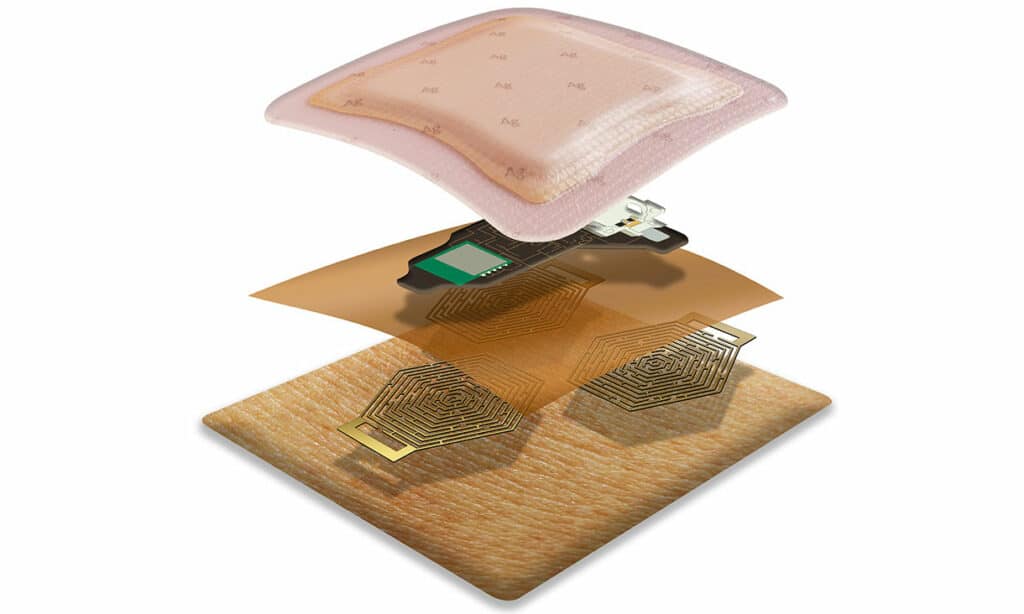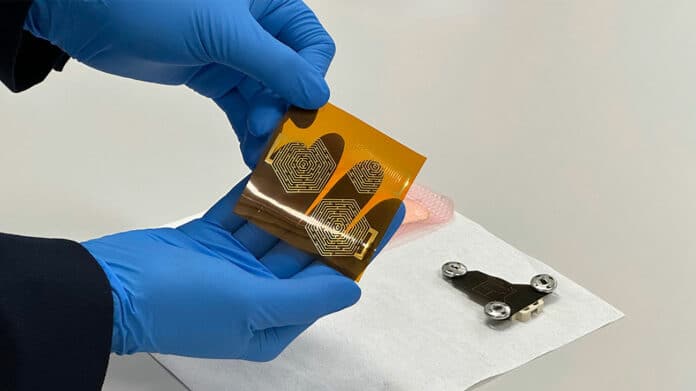Wearable electronic devices, particularly for health monitoring, have made significant progress in recent years. One of the most crucial biophysical parameters in a wearable device is the electrocardiogram (ECG), which plays a very important role in early detection and ongoing treatment of cardiovascular disease, one of the major causes of death in the world.
For wearable ECG devices, the electrode design and material are essential factors that can impact the sensor’s performance. Conventional wet electrodes that contain a conductive gel are widely used to measure ECG signals. These electrodes are often uncomfortable, dry out over time, and have been known to cause irritation.
Now, researchers at RMIT University have developed a new compact, lightweight, gel-free, and waterproof ECG electrode for continuous heart monitoring that offers more comfort and less skin irritation compared to similar heart monitoring devices on the market.
The wearable ECG device could be used to prevent heart attacks for people with cardiovascular disease, including in remote healthcare and ambulatory care settings. The RMIT device is a breakthrough in wearable ECG technology, as it is much lighter and smaller than conventional monitors.
“Commercially available wearable ECG devices are usually bulky, heavy and have 12 ‘wet’ electrodes connecting the patient to the device, whereas the RMIT invention can fit in the palm of your hand,” Professor Madhu Bhaskaran, Deputy Director (Research) of the ARC Hub for Connected Sensors for Health at RMIT said. “The device has just three ‘dry’ electrodes that are almost invisibly thin, can sense even the slightest signals of a heart in distress, and can also be recycled.”
Wet electrodes contain a conductive gel to increase signal gain for improved electrical signal acquisition. In contrast, dry electrodes do not need this gel to operate effectively.

Researchers chose gold (Au) as the dry electrode material for their device, as it gives the added advantage of having an electrode that is chemically inert for all biological processes, highly conductive, and biocompatible.
Incorporating gold thin films allows for lightweight electrodes with a larger surface area-to-volume ratio, which ultimately aids in acquiring ECG signals more effectively. Researchers used electrodes with a thickness of 150 nm in their experiment.
The team studied the influence of surface area, perimeter, and resistance offered by the electrodes on the ECG signal acquisition and its effects on device performance.
After extensive experimentation, the team found the hexagonal labyrinth configuration to be the most suitable candidate – as it suits the curvy nature of skin and active lifestyles and more accurately captures ECG signals, compared with other wearable devices on the market. The design matches the performance of a commercially available portable ECG monitor when attached to the chest area across the fourth intercostal space.
The device weighs only 10 grams, compared to hundreds of grams for most other devices.
The researchers compared the sensing performance of their miniaturized three-electrode ECG device with a 12-electrode wearable monitor available in the market. They found that their device could measure the heart’s electrical activity with a similar level of accuracy.
Lead author PhD scholar Peter Elango from RMIT said dry electrodes offered some significant advantages. Dry electrodes prioritize user comfort, remain durable over time, and reduce the likelihood of skin irritation.
“The device can capture ECG signals even when it is fitted behind a person’s neck – ideal for patients in the aged care sector, including for someone with dementia who may remove it from their chest,” he said in a statement. “The electrodes are also hydrophobic, meaning they don’t get wet, and so a user can wear the device while they do activities in the water such as swimming and showering – unlike other ECG monitors. These attributes make them ideal for continuous monitoring – a crucial feature for wearable ECG devices.”
“The dry electrodes, which are less than one-tenth the width of a human hair, are highly sensitive to the cardiac signals of the user,” Elango added.
Journal reference:
- Peter Francis Mathew Elango, Shanmuga Sundar Dhanabalan, Md Rokunuzzaman Robel, Sherly Pushpam Elango, Sumeet Walia, Sharath Sriram, Madhu Bhaskaran. Dry electrode geometry optimization for wearable ECG devices. AIP Applied Physics Reviews, 2023; DOI: 10.1063/5.0152554
